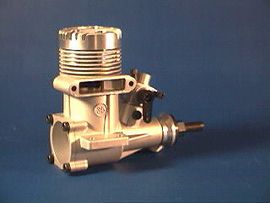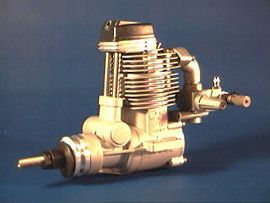

| Getting To Know R/C Engines |
 R/C
model aircraft can be powered by several different types of 'engines'
including electric motors, petrol engines and most commonly by 2 stroke
and 4 stroke glow engines. Each have there own advantages and disadvantages
but all are widely used world-wide. Your choice will depend on the type
and size of your aircraft, and most importantly, the noise limitations
at your flying site, and of course how much you want to spend.
R/C
model aircraft can be powered by several different types of 'engines'
including electric motors, petrol engines and most commonly by 2 stroke
and 4 stroke glow engines. Each have there own advantages and disadvantages
but all are widely used world-wide. Your choice will depend on the type
and size of your aircraft, and most importantly, the noise limitations
at your flying site, and of course how much you want to spend.
'Glow'
Engines
Model glow engines come in two forms 2 stroke and 4 stroke. Both use
"glow fuel" which is a mixture of methanol combined with castor and/or
synthetic oil. The oil acts as a total loss lubricant. The biggest difference
between the two types is the way fuel is delivered to and exhaust is removed
from the engine during operation.
 In
a 2 stroke engine the fuel/air mixture metred by the carburettor is forced
into the combustion chamber during the down stroke of the piston. During
the upstroke the mixture is compressed and when the piston reaches the
top of its stroke, the glow plug ignites the compressed gases, forcing
the piston down. On the way down exhaust gases escape through the exhaust
port while the fuel mixture enters the chamber. The entire power cycle
takes place in 2 strokes of the piston.
In
a 2 stroke engine the fuel/air mixture metred by the carburettor is forced
into the combustion chamber during the down stroke of the piston. During
the upstroke the mixture is compressed and when the piston reaches the
top of its stroke, the glow plug ignites the compressed gases, forcing
the piston down. On the way down exhaust gases escape through the exhaust
port while the fuel mixture enters the chamber. The entire power cycle
takes place in 2 strokes of the piston.
In
a 4 stroke engine the fuel/air mixture metred by the carburettor is delivered
into the combustion chamber during the downstroke of the piston through
a valve operated by a pushrod via the crankshaft. On the upstroke the
valve closes and the mixture is compressed. When the piston reaches the
top of its stroke, the glow plug ignites forcing the piston down. On the
next upstroke of the piston a second valve opens and allows the exhaust
gases to escape. The fuel mixture then again enters on the down stroke.
The entire power cycle takes place in 4 strokes of the piston. 
The glow plug is common to both 2 stroke and 4 stroke engines and is made up of a very small coil of platinum wire. To start the engine, an electric current, provided by a 1.5 volt battery, must run through the coil to heat it. The engine is then turned over to make the engine start running. Once the combustion cycle has started, the coil in the glow plug can retain heat between firing and the electric current is no longer required.
The mixture for both types of glow engines is usually adjusted by two needle valves on the carburettor. One needle valve adjusts mixture for idle and low speed operation while the other is for high speed mixture adjustment. Engines for control line models do not usually have carburettors and operate only at full throttle. A needle valve is mounted at the air intake and provides mixture adjustment for high speed only.
Throttle control for R/C engines is usually accomplished via a rotating barrel in the carburettor. This barrel controls the amount of fuel/air mixture going to the combustion chamber and is activated by a small arm mounted on the side of the carburettor and controlled from one channel & servo.
Two stroke engines are the most common model engine found on our aircraft. They are simple, light, easy to operate and easy to maintain, and are generally inexpensive. They operate at a high RPM but can be quite loud therefore needing a good silencer. Four stroke engines are increasingly popular. They produce a lower, more scale- like sound. They produce their power at lower RPM than two stroke engines. Because of their high precision engineering, and more parts they are usually more expensive than two stroke engines. They also need more maintenance and adjustment than their two-cycle counterparts but they are not difficult to operate and maintain.
Electric
Motors
Electric Motors are the newest form of power for model aircraft. With
ever increasing improvements in NiCad battery technology over the last
few years, electric motors have really become a reliable from of power.
Electric power is usually provided by a series of NiCad cells made up into packs. Six and seven cell packs are most common while larger motors may require up to 28 or more cells. These are light and can be recharged quickly in about 15 to 30 minutes. The run time is usually in the 4 to 10 minute range.
Petrol
Fuelled Engines
Petrol fuelled engines are becoming a popular way to power larger
model aircraft. They don't usually come in the small sizes usually seen
powering our standard sized model aircraft but for the large models they
provide good power with a reasonable cost and inexpensive to run. A spark
plug provides the combustion and no external power source is required
to start the engine. Fuel is usually a petrol and oil mixture.
| So Which Engine Should I Choose? |
Bushes or Ball Bearings?
You can get engines with either plain bushed supported crankshaft
or with ball bearings. Ball bearing engines usually have a better performance,
run smoother, and last longer with proper maintenance but are more expensive
than those with bushings.
ABC
or Ringed?
The piston and cylinders for model engines are constructed in one
of two methods; ringed or ABC. Piston ringed engines have been used on
model engines for a long time and were the main method of construction
until recently. An aluminium or iron piston with a piston ring moves in
an iron sleeve. The ring provides the seal between cylinder and piston
giving the required compression. Ringed engines are easy to flick start,
generate good power, are inexpensive to restore compression after long
usage by simply replacing the ring. However, ringed engines need a long
running-in period where the motor is run very rich to provide lots of
lubrication while the ring fits itself to the cylinder. They are also
more easily damaged if the engine is run too lean.
More recently a method of construction has been developed called ABC (Aluminium, Brass, Chrome) where an aluminium piston runs in a chrome plated brass sleeved cylinder. The piston and cylinder are matched at the factory to give a perfect fit and provide optimum compression. An ABC engine starts easily by hand, and produce more power than their ringed cousin. They also have a good lifespan, and are less prone to damage when run lean. They are a little more expensive to buy but very expensive to restore compression if required, as the entire piston/cylinder assembly must be replaced. One great advantage is that they require little or no running in period.